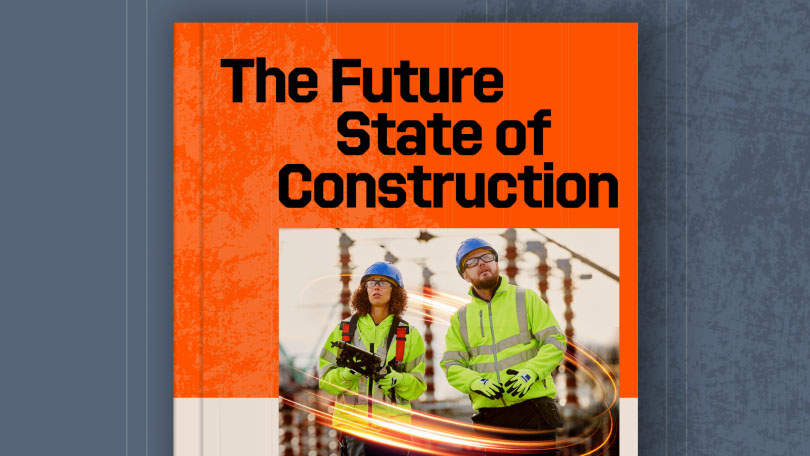— 9 min read
9 Construction Risks Every Contractor & Owner Must Know

Last Updated Nov 25, 2025

Emma De Francesco
Strategic Product Consultant
21 articles
Emma is currently Strategic Product Consultant at Procore where she loves partnering with clients to help them achieve the best possible results. She has worked as a Project Manager in previous roles, responsible for overseeing small to medium-sized projects across various sectors including commercial, health and lifestyle, retail, government and hotels. Throughout these projects, she managed everything from project costs, program and quality & safety, to design management, procurement, and authority approvals.

Nicholas Dunbar
Content Manager
62 articles
Nick Dunbar oversees the creation and management of UK and Ireland educational content at Procore. Previously, he worked as a sustainability writer at the Building Research Establishment and served as a sustainability consultant within the built environment sector. Nick holds degrees in industrial sustainability and environmental sciences and lives in Camden, London.

Zoe Mullan
27 articles
Zoe Mullan is an experienced content writer and editor with a background in marketing and communications in the e-learning sector. Zoe holds an MA in English Literature and History from the University of Glasgow and a PGDip in Journalism from the University of Strathclyde and lives in Northern Ireland.
Last Updated Nov 25, 2025

Construction ranks amongst the toughest and most volatile industries, typically seeing one of the highest business failure rates across all economic sectors. While construction offers lucrative opportunities, it also carries substantial risk.
Construction leaders now turn to technology and other solutions to gain better control over how they build. Predicting future risks and taking steps to mitigate their impact determines the success of any project. Although entirely eliminating risk is impossible, identifying common risk sources marks the first step in minimising loss.
UK contractors face construction project risks every day. Below, we explore the most common issues that disrupt project programmes, erode profit margins, and drive expensive, lengthy disputes.
Table of contents
Construction Risk Categories
The risks outlined below fall into four broad categories that clarify accountability:
- Financial: Cost overruns, price escalation and retention
- Contractual: Variations, payment notices and adjudication
- Operational: Programme delays, labour gaps, plant theft and poor project management
- Environmental: Adverse weather, ground conditions, sustainability and regulatory change
9 Construction Risks
1. Programme Delays
Delays represent one of the most common risks in construction. Pushing back delivery dates affects everyone on the job. Poor project management, permitting and inspections, supply chain disruptions, variations, accidents and adverse weather all contribute to delays.
Activities at any level of the chain – both in the office and onsite – can trigger delays. Owners and principal/main contractors must therefore establish clear communication processes that employees, subcontractors and vendors can easily use. The earlier teams identify and communicate potential delays to the construction manager, the faster that manager can act to avoid or reduce the delay.
UK sites also face increasingly volatile weather. Storm Eunice, for example, shut down jobsites for up to two days in February 2022. Including a time-risk allowance of 5–10% in the baseline programme, together with flood-risk assessments in Risk Assessment Method Statements (RAMS), cushions the impact of inevitable weather-related stoppages.
2. Documentation Errors
The Arcadis 2022 Construction Costs Report identified errors and omissions in contract documents as the second-highest cause of disputes globally. The increasing size and complexity of commercial and public projects, combined with pressure to accelerate construction, create more potential for mistakes during preconstruction. Errors in drawings, specifications and design coordination lead to increased capital costs and programme delays.
Documentation problems extend well beyond preconstruction. Main contractors and subcontractors must often meet stringent notice deadlines and submission requirements. Documentation errors or missed deadlines delay payments and can even invalidate a contractor's right to file a claim.
The sheer volume of documents required to complete a project compounds this risk. These include:
- Drawings
- Submittals
- Notices
- Applications for Payment
- Vesting certificates
- Variations
UK best practice now expects digital collaboration inside a Common Data Environment compliant with ISO 19650. Storing sensitive project files in a GDPR-compliant platform with role-based access limits data-protection exposure.
3. Change Management
Any material change to the contract after construction begins poses significant risk to owners, contractors and suppliers alike, as it affects time, scope of work, materials and cost.
When the principal contractor receives a Request for Information (RFI) from the owner directing them to make a material change to the project, this kicks off a waterfall of events down the chain. The principal contractor then issues RFIs to each subcontractor whose work the change impacts.
Ideally, each subcontractor would submit a variation detailing the required cost and programme adjustment, then wait for the owner's approval before beginning the work. However, in the real world, contractors frequently start work before receiving approval in an effort to avoid or reduce programme delays. In this all-too-common scenario, payment disputes between the owner and contractors become a near inevitability.
Preventing risk around change management begins during preconstruction. The more time and effort teams spend investigating site conditions and reviewing drawings and site plans for accuracy, the fewer changes they require after breaking ground. During the project, owners and contractors should follow a clear and efficient process for communicating and managing changes, doing everything possible to reduce the time between RFIs and variation approval.
Contractors can greatly reduce their risk of payment disputes over contract changes by obtaining an approved variation before beginning the work.
Under NEC contracts, this means issuing an Early Warning followed by a Compensation Event notification; under JCT, this requires issuing a 'Relevant Event' notice for time extensions and a 'Relevant Matter' application for loss and expense, strictly adhering to the contract's specific notice periods.
4. Subcontractor Default
Subcontractor default poses a serious risk, especially on complex projects that require numerous subcontractors to complete specialised portions of work. The larger the project, the greater the number of subcontractors on the job. Pressure to accelerate construction often requires trade stacking and tight programmes with a very slim margin for error. When a subcontractor defaults on their contract or otherwise fails to perform, the entire project suffers, especially if their scope of work falls on the critical path.
Pre-qualify firms through Safety Schemes in Procurement or Constructionline, verify UKCA certification on critical products and confirm suitable insurance cover for Professional Indemnity, Contractors' All-Risks and latent defects before appointing the package.
5. Supply Chain Disruption
Building material shortages and price escalations impact programmes, construction costs and profit margins. Over the last few years, the global supply chain has experienced frequent setbacks and disruptions, with wide-ranging impacts on construction in progress.
Timber, steel and other materials have shown volatile pricing. Steel prices, for example, rose by approximately 50% in 2021; projects without fluctuation clauses experienced cost overruns. Many contractors have also struggled simply to secure delivery of necessary materials. Shipping and trucking issues – exacerbated by the post-Brexit HGV driver shortage – natural disasters, business closures, spikes in demand, fuel prices, economic recession, and strikes and labour disputes all drive cost increases and shortages.
Many construction contracts include a price-escalation clause to balance risk between the contractor and owner. Construction managers and owners must keep a close eye on supply-chain developments, dual-source UK suppliers where possible and track Consumer Prices Index (CPI)-linked indices. A flexible, diversified supply chain is now essential for projects of any size.
6. Poor Project Management
Poor project management leads to miscommunication, delays and disputes. When a principal contractor or construction manager lacks clarity on expectations or fails to manage subcontractors effectively, time and materials are wasted.
The effects of poor project management ripple across other projects as well, increasing risk for subcontractors. When sloppy project management delays a subcontractor's work, it disrupts programmes on other jobs and makes labour and plant coordination an impossible task.
CDM 2015 places specific duties on the principal contractor and the newly created principal designer role. Failing to plan, manage and monitor the works also jeopardises compliance with the Building Safety Act 2022, which requires a live 'Golden Thread' of digital information and an up-to-date Health and Safety File throughout the build.
7. Labour Shortages and Poorly Scoped Work
Labour presents a construction risk on projects of any size. Finding qualified, reliable employees is a challenge for businesses in every industry. The workforce lined up for a project can fall through.
When a contractor takes on a project and discovers they lack the workforce to finish it, this slows everyone on the job down. Again, this pushes out the programme and cuts into profitability.
On union projects, the potential for a strike creates additional risk. Solidarity across union branches can mean your entire union workforce walks off the project in protest of working conditions on another job beyond your control.
Off-payroll working (IR35) adds a separate tax risk when engaging self-employed operatives. Misclassifying workers can trigger HMRC penalties, so carry out status assessments early.
Keeping a project on track becomes difficult when the track itself is unclear. A poorly defined scope of work creates a management issue that usually rolls downhill. Contractors working under a fixed-price or lump-sum contract should pay close attention to:
- Site conditions
- Customer input
- Materials pricing
These factors drive project costs up and profit margins down. However, mechanisms like cost-plus contracts can help mitigate the risks of poorly defined scopes. Improving communication at every project level leads to a better-defined scope and helps organisations stay profitable by avoiding scope creep.
8. Health and Safety Hazards
The building industry consistently ranks amongst the most dangerous sectors. Health and safety hazards present a frequent concern for construction businesses, who want to maintain a healthy workforce and avoid financial losses from increased compensation premiums or penalties from safety violations.
The Health and Safety Executive (HSE) reports that construction suffered 51 fatal injuries in 2023/24 – a rate of 2.43 per 100,000 workers – and around 5,000 asbestos-related deaths happen each year. The HSE focuses on four acute hazards:
- Falls from height
- Struck by moving vehicle
- Struck by flying/falling object
- Trapped by something collapsing/overturning
Chronic threats such as silicosis, COPD, noise-induced hearing loss and Hand-Arm Vibration Syndrome also demand attention.
Meeting requirements under COSHH, the Noise at Work Regulations 2005 and the Control of Vibration at Work Regulations 2005 forms part of effective safety management. This includes keeping vibration exposure below 5 m/s² A(8), using water suppression, FFP3 respirators, daily HAV readings and toolbox talks, and updating the Health and Safety File as works progress. HSE guidance HSG150 provides further detail, while CITB grants can subsidise Site Safety Plus and mental-health-first-aider training
9. Payment Disputes
Payment times in construction are amongst the longest of all industries. Slow payments create risk for everyone on a project, at all levels of the chain. Payment problems disrupt contractor cash flow and increase the risk of default. They also increase an owner's risk of statutory adjudication on the property as contractors and suppliers act to recover unpaid contractual amounts
Payment disputes arise frequently from funding and financing delays, variations, retention, vesting certificates, contra-charges and work-quality disputes.
Comprehensive documentation, clear communication and close adherence to contract requirements are vital for contractors to make their case if it ends up in court – or in a 28-day statutory adjudication triggered under Section 108 of the Housing Grants, Construction and Regeneration Act 1996. Issue 'Payment Notices' and, where necessary, 'Pay Less Notices' on time. Public-sector frameworks increasingly ring-fence funds in Project Bank Accounts to protect the supply chain.
The Risk Management Cycle
Successful UK projects apply a simple, four-step cycle:
- Identify each risk
- Assess its probability and impact
- Respond with one of the four classic actions – avoid, transfer, mitigate or accept
- Monitor progress throughout the programme
Build in a programme contingency and review your risk register at every project board meeting to keep inevitable surprises from derailing delivery.
By understanding these common construction risks and integrating robust management processes, UK contractors and owners can build with greater confidence, protect margins and hand over safer, higher-quality assets.
Categories:
Written by

Emma De Francesco
Strategic Product Consultant | Procore
21 articles
Emma is currently Strategic Product Consultant at Procore where she loves partnering with clients to help them achieve the best possible results. She has worked as a Project Manager in previous roles, responsible for overseeing small to medium-sized projects across various sectors including commercial, health and lifestyle, retail, government and hotels. Throughout these projects, she managed everything from project costs, program and quality & safety, to design management, procurement, and authority approvals.
View profileReviewed by

Nicholas Dunbar
Content Manager | Procore
62 articles
Nick Dunbar oversees the creation and management of UK and Ireland educational content at Procore. Previously, he worked as a sustainability writer at the Building Research Establishment and served as a sustainability consultant within the built environment sector. Nick holds degrees in industrial sustainability and environmental sciences and lives in Camden, London.
View profile
Zoe Mullan
27 articles
Zoe Mullan is an experienced content writer and editor with a background in marketing and communications in the e-learning sector. Zoe holds an MA in English Literature and History from the University of Glasgow and a PGDip in Journalism from the University of Strathclyde and lives in Northern Ireland.
View profileExplore more helpful resources

Control the Chaos: Standardising Document Workflows in Construction Projects
Document control and implementation play a central role in managing risk, meeting deadlines, and delivering projects to spec. As builds become more complex and teams increasingly disperse, the volume and...

Cost-Plus Construction Contracts in the UK
A construction cost-plus contract – sometimes called a cost-reimbursable or prime cost contract – reimburses all project costs and adds a fee to cover the contractor’s overhead and profit. UK...

Digital Construction Technology for Whole-Life Value
For decades, the construction industry has kept a narrow focus on capital cost — the one-time, upfront costs of a construction project. While in the short term this seems like...

UK Construction Progress Reports: Tools for Smarter Site Management
Construction progress reports track completed work, on site issues, costs, and safety so UK project teams can demonstrate progress, secure payments, and stay on programme. Accurate progress data is essential...
